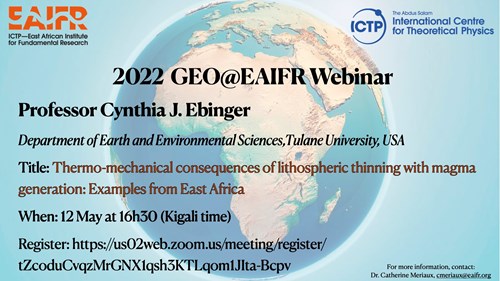ICTP-East African Institute for Fundamental Research
KIST2 Building CST
Nyarugenge Campus
University of Rwanda
Kigali, Rwanda
GEO@EAIFR webinar. 2022 Series.
Professor Cynthia J. Ebinger will give a GEO@EAIFR webinar discussing the thermo-mechanical consequences of lithospheric thinning with magma generation using examples from East Africa.

The East African Institute for Fundamental Research (EAIFR) and the International Centre for Theoretical Physics (ICTP) wish to inform those who may be interested of a GEO@EAIFR webinar. This seminar will take place on May 12, 2022 and will be broadcast live on ZOOM. It will also be recorded and later posted on the ICTP-EAIFR YouTube channel, where one can find the previous recorded GEO@EAIFR webinars. Below all the details:
Speaker: Professor Cynthia J. Ebinger from the Department of Earth and Environmental Sciences at Tulane University (USA).
Title: Thermo-mechanical consequences of lithospheric thinning with magma generation: Examples from East Africa
When: 12 May 2022 at 16h30 (Kigali time)
Register in advance for this meeting by clicking here.
All are very welcome.
Biography:
Cynthia Ebinger is the Marshall-Heape Professor in the Department of Earth and Environmental Sciences at Tulane University. Her research focuses on tectonic and volcanic processes occurring in rift zones, and their implications for earthquake and volcanic hazards, and for geothermal energy. She and her research team utilize satellite and geophysical data to image and model Earth's structure and state-of-stress, and to detect change associated with natural and anthropogenic processes. In the course of field and laboratory studies, she has worked with scientists in African and South American countries to address hazard and energy challenges and to build regional networks. Ebinger is Chair of the American Geophysical Union College of Fellows, a Fellow of the Geological Society of America, and she serves on the advisory board for the International Centre for Theoretical Physics - East African Institute for Fundamental Research geophysics program. Ebinger received an SM and PhD in marine geophysics from the M.I.T./Woods Hole Oceanographic Institution Joint Program, and a BSc in marine geology from Duke University. She has served as Editor-in-Chief for Geophysical Journal International and Basin Research and as associate editor for Journal of Geophysical Research and Journal of African Research.
Abstract:
Continental rifts are zones of lithospheric stretching and thinning, as well as crustal growth achieved through the processes of magma intrusion and eruption, and the areal extension of continental surface area. Flood magmatism may precede initial extension, and significantly increase the volume of the crust through widespread plumbing systems and km-thick extrusive flows. The thermo-mechanical consequences of heat transfer from thinning and stretching, the compositional changes from magma intrusion and metasomatic alteration reactions, and density changes on plate strength are reviewed. We synthesize geophysical constraints on crustal structure in flood basalt and continental rift zones, and interpret them in light of geochemical and geological data to evaluate the role of magmatism in shaping the crust beneath rift zones. We use examples from the active Ethiopia-Yemen flood basalt province, the Eastern and Main Ethiopian rifts, Taupo Volcanic Zone (TVZ), New Zealand and review their implications for ancient magmatic rift zones, like the Parana, and magmatic passive margins. These observations of time-averaged processes reveal progressive changes in rifting processes as intrusive volume increases, and as magma rises to shallower crustal storage chambers, suggesting that the volume of magma available is as or more important than stretching factor.



